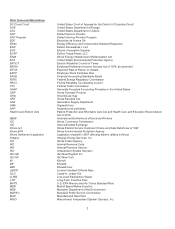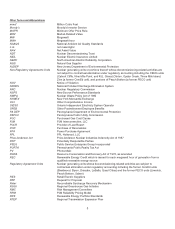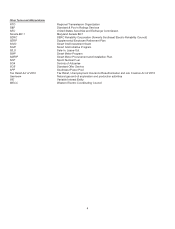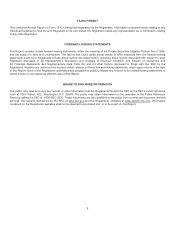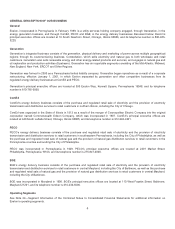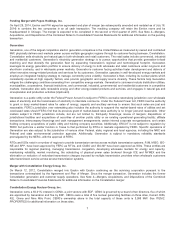Exelon 2014 Annual Report Download - page 16
Download and view the complete annual report
Please find page 16 of the 2014 Exelon annual report below. You can navigate through the pages in the report by either clicking on the pages listed below, or by using the keyword search tool below to find specific information within the annual report.nuclear uprate implementation plan was adjusted during 2013 to cancel certain projects. The Measurement Uncertainty Recapture
uprate projects at the Dresden and Quad Cities nuclear stations were cancelled as a result of the cost of additional plant
modifications identified during final design work which, when combined with then current market conditions, made the projects not
economically viable. Additionally, the market conditions prompted Generation to cancel the previously deferred extended power
uprate projects at the LaSalle and Limerick nuclear stations. During 2013, Generation recorded a pre-tax charge to operating and
maintenance expense and interest expense of approximately $111 million and $8 million, respectively, to accrue remaining costs
and reverse the previously capitalized costs.
Under the nuclear uprate program, Generation has placed into service projects representing 393 MWs of new nuclear generation at
a cost of $1,193 million, which has been capitalized to property, plant and equipment on Exelon’s Consolidated Balance Sheets. At
December 31, 2014, Generation has capitalized $122 million to construction work in progress within property, plant and equipment
for nuclear uprate projects expected to be placed in service by the end of 2016, consisting of 139 MWs of new nuclear generation
that is in the installation phase at one nuclear station, Peach Bottom in Pennsylvania. The remaining spend associated with this
project is expected to be approximately $125 million through the end of 2016. Generation believes that it is probable that this project
will be completed. If a project is expected not to be completed as planned, previously capitalized costs will be reversed through
earnings as a charge to operating and maintenance expense and interest.
Nuclear Waste Disposal. There are no facilities for the reprocessing or permanent disposal of SNF currently in operation in the
United States, nor has the NRC licensed any such facilities. Generation currently stores all SNF generated by its nuclear generating
facilities in on-site storage pools or in dry cask storage facilities. Since Generation’s SNF storage pools generally do not have
sufficient storage capacity for the life of the respective plant, Generation has developed dry cask storage facilities to support
operations.
As of December 31, 2014, Generation had approximately 73,800 SNF assemblies (18,300 tons) stored on site in SNF pools or dry
cask storage (this includes SNF assemblies at Zion Station, for which Generation retains ownership even though the responsibility
for decommissioning Zion Station has been assumed by another party; see Note 15—Asset Retirement Obligations of the Combined
Notes to Consolidated Financial Statements for additional information regarding Zion Station Decommissioning). All currently
operating Generation-owned nuclear sites have on-site dry cask storage, except for Clinton and Three Mile Island. Clinton and Three
Mile Island are anticipated to lose full core reserve, which is when the on-site storage pool will no longer have sufficient space to
receive a full complement of fuel from the reactor core, in 2015 and 2023, respectively. Dry cask storage will be in operation at
Clinton and is expected to be in operation at Three Mile Island prior to losing full core offload capability in their respective on-site
storage pools. On-site dry cask storage in concert with on-site storage pools will be capable of meeting all current and future SNF
storage requirements at Generation’s sites through the end of the license renewal periods and through decommissioning.
For a discussion of matters associated with Generation’s contracts with the DOE for the disposal of SNF, see Note 22—
Commitments and Contingencies of the Combined Notes to Consolidated Financial Statements.
As a by-product of their operations, nuclear generating units produce LLRW. LLRW is accumulated at each generating station and
permanently disposed of at licensed disposal facilities. The Federal Low-Level Radioactive Waste Policy Act of 1980 provides that
states may enter into agreements to provide regional disposal facilities for LLRW and restrict use of those facilities to waste
generated within the region. Illinois and Kentucky have entered into such an agreement, although neither state currently has an
operational site and none is anticipated to be operational until after 2020.
Generation ships its Class A LLRW, which represents 93% of LLRW generated at its stations, to disposal facilities in Utah and South
Carolina. The disposal facility in South Carolina at present is only receiving LLRW from LLRW generators in South Carolina, New
Jersey (which includes Oyster Creek and Salem), and Connecticut.
Generation utilizes on-site storage capacity at its Peach Bottom and LaSalle stations to store Class B and Class C LLRW for all
stations in Generation’s nuclear fleet, as approved by the NRC. Generation has a contract through 2032 to ship Class B and Class C
LLRW to a disposal facility in Texas. The agreement provides for disposal of all current Class B and Class C LLRW currently stored
at the Peach Bottom and LaSalle stations as well as the Class B and Class C LLRW generated during the term of the
agreement. However, because the production of LLRW from Generation’s nuclear fleet will exceed the capacity at the Texas site
(3.9 million curies for 15 years beginning in 2012), Generation will still be required to utilize on-site storage at its Peach Bottom and
LaSalle stations for Class B and Class C LLRW. Generation currently has enough storage capacity to store all Class B and C LLRW
for the life of all stations in Generation’s nuclear fleet. Generation continues to pursue alternative disposal strategies for LLRW,
including an LLRW reduction program to minimize cost impacts and on-site storage.
12


